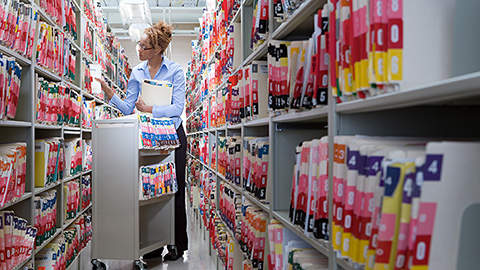
Giant, intricate structures
Structural biologists increasingly are able to determine in intricate detail the baroque structures of large protein complexes with important roles in the cell. This year, that was especially clear with the nuclear pore complex, or NPC.
A special issue of the journal Science featured five papers that tackled the NPC from various angles and in different species, in what senior editor Di Jiang called “a triumph of experimental structural biology.”
The nuclear pore complex includes four rings built from symmetrically repeated patterns of about 30 nucleoporin proteins. The complex is enormous, comprising roughly 1,000 protein subunits in total. This structure controls access to the nucleus, selectively allowing cargo such as signaling proteins and mRNAs in or out of the nucleus. It also, researchers recently have shown, can dilate and contract, changing the diameter of the central channel by almost 50%.

Building on advances in the structure of the human NPC’s core rings published in 2016, three research teams tackled the cytoplasmic face of the NPC in human, frog and yeast cells. Each combined knowledge about the structures of individual nucleoporins and small groups of proteins, determined through biochemistry, crystallography or protein structure prediction, with larger-scale but blurrier models of the NPC as a whole derived from cryo-electron microscopy or tomography. Hao Wu, a structural biologist at Harvard Medical School who led one of the research teams, compared the workflow to solving a jigsaw puzzle by fitting the smaller subunits into the larger complex’s outlines.
One of the three teams that studied the cytoplasmic face, led by Andre Hoelz at Caltech, also published a second paper investigating linker nucleoporins buried deep in the core in the nuclear envelope. The team probed the combination of flexible and tight crosslinks that allow the inner channel of the NPC to dilate but also constrain its expansion.
A fourth team, from Martin Beck’s lab at the Max Planck Institute of Biophysics, published an integrative structural analysis that took on the whole NPC. The researchers used cryo-electron tomography to develop a model of the whole complex in its constricted and dilated conformations along with structural prediction to figure out multiple possible conformations of uncharacterized scaffold nucleoporins. Like the researchers studying the cytoplasmic face of the NPC, the team then fit these subunits into a larger model — this one equipped for molecular dynamics simulations that enabled them to predict how the pore complex as a whole might move.
The work has important implications for how the cell builds one of its most complex machines and for understanding how various molecules pass in and out of the nucleus. It also has inspired researchers to use similar techniques to tackle other large complexes.
“We are now looking at other highly complex structures,” Wu said.
Enjoy reading ASBMB Today?
Become a member to receive the print edition four times a year and the digital edition monthly.
Learn moreGet the latest from ASBMB Today
Enter your email address, and we’ll send you a weekly email with recent articles, interviews and more.
Latest in Opinions
Opinions highlights or most popular articles

How pediatric cataracts shaped my scientific journey
Undergraduate student Grace Jones shares how she transformed her childhood cataract diagnosis into a scientific purpose. She explores how biochemistry can bring a clearer vision to others, and how personal history can shape discovery.

Debugging my code and teaching with ChatGPT
AI tools like ChatGPT have changed the way an assistant professor teaches and does research. But, he asserts that real growth still comes from struggle, and educators must help students use AI wisely — as scaffolds, not shortcuts.

AI in the lab: The power of smarter questions
An assistant professor discusses AI's evolution from a buzzword to a trusted research partner. It helps streamline reviews, troubleshoot code, save time and spark ideas, but its success relies on combining AI with expertise and critical thinking.

How AlphaFold transformed my classroom into a research lab
A high school science teacher reflects on how AI-integrated technologies help her students ponder realistic research questions with hands-on learning.

Writing with AI turns chaos into clarity
Associate professor shares how generative AI, used as a creative whiteboard, helps scientists refine ideas, structure complexity and sharpen clarity — transforming the messy process of discovery into compelling science writing.

Teaching AI to listen
A computational medicine graduate student reflects on building natural language processing tools that extract meaning from messy clinical notes — transforming how we identify genetic risk while redefining what it means to listen in science.

